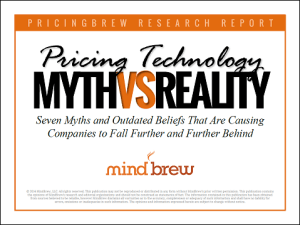When we talk about pricing technologies, the minds of many pricing professionals will immediately begin thinking about process automation—i.e. price list or catalog updating, price exception routing, configured product price calculation, quote-to-invoice reconciliation, competitive price scraping, etc.
Of course, this “default concept” of pricing technology isn’t too surprising, given that the initial applications of technology toward pricing problems have typically been focused on removing the friction in the process steps, making interactions and handoffs smoother, and reducing the administrative burdens.
But while technology has, and will continue to be, extremely useful for improving process efficiency, there’s a much larger opportunity available…
You see, the pricing technologies available today can address much “smarter” problems than most people even realize. The solutions available today are going well beyond pricing process automation and actually working to improve the quality and accuracy of the price-points themselves.
And as we’ve been saying for a very long time, the benefits of more efficient pricing processes pale in comparison to the profitability gains you’ll realize by fielding more effective prices.
What are some of these smarter problems being addressed by today’s pricing technologies? Here are just a few of the applications we’re aware of:
- Identifying the specific transaction-level segmentation attributes that signal willingness-to-pay differences.
- Measuring and monitoring price elasticity levels in thousands of different price segments on an ongoing basis.
- Determining the segment-level prices that will best achieve a set of stated objectives within known constraints.
- Predicting and projecting how specific prices or price changes will ultimately impact revenue and profit production.
- Optimizing individual product prices while maintaining the desired good-better-best product relationships.
- Identifying, quantifying, and prioritizing customer- or account-specific pricing outliers and unearned discounts.
- Modeling and comparing the most likely outcomes of various pricing scenarios and different strategies.
Obviously, these are not your run-of-the-mill efficiency issues. These are much bigger and far more impactful than the typical process automation plays. And I think you’ll agree that any technology that can address these types of pricing issues is a very “smart” technology indeed!
The point is that while pricing process automation solutions are certainly worthwhile, they aren’t the only pricing technologies you should be exploring. And once you break free of the default concept and see what these smarter pricing solutions can do, I think you’ll find that they make a lot more sense than just trying to squeeze another drop from the process automation turnip.














